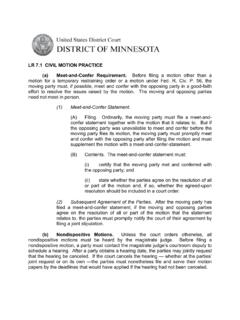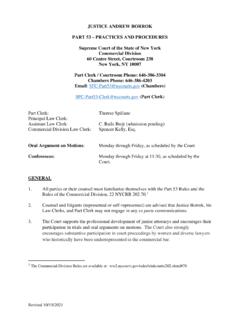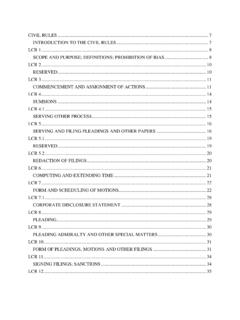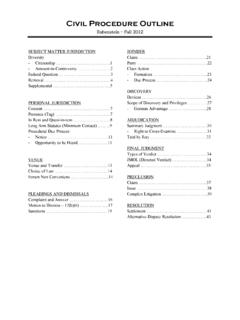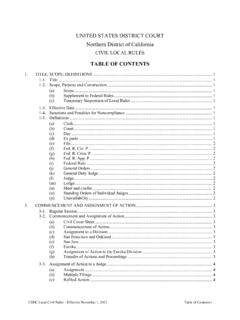Transcription of Third Circuit Civil Appeals: Appellee’s Brief, Reply Brief ...
1 2018 Thomson Reuters. All rights the Resource ID numbers in blue on Westlaw for more. Resource ID: W-012-3358 Third Circuit Civil Appeals: Appellee s Brief , Reply Brief , and Cross-AppealsSTEPHEN M. ORLOFSKY AND ADRIENNE C. ROGOVE, BLANK ROME LLP, WITH PRACTICAL LAW LITIGATIONA Practice Note explaining how to prepare and submit the appellee s Brief and the appellant s Reply Brief in Civil appeals to the United States Court of Appeals for the Third Circuit from a federal district court s order or judgment. This Note also explains how to Brief cross-appeals, and how to submit supplemental authorities using so-called Rule 28(j) the appellant files its opening Brief , the appellee responds with a Brief of its own. The appellant then has an opportunity to Reply . If both parties appeal, the appellee has an opportunity to Reply in support of its cross-appeal. Whether the briefing ends after the Third or fourth Brief , the parties can submit any significant legal authority of which they become aware after briefing and before argument.
2 This Note explains briefing schedules in the Third Circuit , how to compile and format the appellee s Brief and Reply Brief , cross-appeals, and Rule 28(j) letters alerting the court to supplemental SCHEDULESThe parties must serve and file their briefs according to the Federal Rules of Appellate Procedure (FRAP) and the local rules for the Third Circuit (3d Cir. ) or, if ordered otherwise, according to a briefing schedule set by the Third Circuit . The parties may request an extension if they have good reasons for being unable to meet the court s deadlines. Attorneys should be aware of the: Time to file and serve briefs (see Timing). Ways to extend the briefing schedule (see Extensions of the Briefing Schedule). Consequences of failing to comply with the briefing schedule (see Failure to Comply with Briefing Schedule).TIMINGThe Third Circuit clerk typically issues a briefing and scheduling order shortly after an appeal is docketed.
3 Unless the court orders otherwise: The appellant must serve and file its opening Brief within 40 days after the date on which the record is filed. The appellee must serve and file its Brief within 30 days after the appellant serves its Brief . The appellant may serve and file a Reply Brief within 14 days after the appellee serves its Brief , but at least seven days before argument, unless the court orders otherwise.(FRAP 31(a)(1), (2).)A party receiving service by US mail or commercial carrier may add three days to the time otherwise available to respond. However, parties receiving a Brief by electronic service may not add three days to a response time. (FRAP 26(c).)If the case is referred to mediation, the court defers establishing a briefing schedule, unless the Chief Circuit Mediator or the court determines otherwise (3d Cir. ).EXTENSIONS OF THE BRIEFING SCHEDULEA party that cannot meet a deadline to file its Brief may ask the court for an extension.
4 The parties may not agree or stipulate to change the briefing schedule on their own. The court does not automatically grant a request for an extension, even where the request is party may make its first request for an extension of 14 days or less by telephone or in writing. The clerk may grant extensions on a showing of good cause. The requesting party should notify opposing counsel before requesting an extension. A party must request an extension at least three days before the Brief s due date. If less than three days remain before the due date, the requesting party must make the request by written motion and demonstrate that good cause for the extension either: Did not exist earlier. Could not with due diligence have been known or communicated to the court earlier.(3d Cir. ) 2018 Thomson Reuters. All rights reserved. 2 Third Circuit Civil Appeals: Appellee s Brief , Reply Brief , and Cross-AppealsThe Third Circuit greatly disfavors second requests for an extension of time to file a Brief .
5 The court grants second extension requests only on a showing of good cause that was not foreseeable when the first request was made. A party must make a second extension request by written motion. (3d Cir. )FAILURE TO COMPLY WITH BRIEFING SCHEDULEIf an appellee fails to timely file its Brief , it is not permitted to participate at oral argument unless the court grants permission (FRAP 31(c)).THE APPELLEE S BRIEFThe appellee s Brief is the primary vehicle for the appellee to explain to the Third Circuit why it should affirm the district court s order or judgment and why the appellant s arguments are OF THE APPELLEE S BRIEFThe appellee s Brief must contain, in order: A cover (see Cover). A corporate disclosure statement and statement of financial interest (see Disclosure Statement). A table of contents (see Table of Contents). A table of authorities (see Table of Authorities).
6 A statement of subject-matter and appellate jurisdiction, where appropriate (see Jurisdictional Statement). A statement of the issues, if desired (see Statement of the Issues). A statement of related cases and proceedings (see Statement of Related Cases and Proceedings). A statement of the relevant facts, if desired (see Statement of the Case). A summary of the argument (see Summary of the Argument). An argument (see Argument). A conclusion, if desired (see Conclusion). A signature (see Signature). A certificate of compliance (see Certificate of Compliance). An electronic document certificate (see Electronic Document Certificate). A certificate of bar admission (see Certificate of Bar Admission). Proof of service (see Certificate of Service).(FRAP 25(d), , 28(a), (b), and 32(a)(2), (d), and (g); 3d Cir. ; 3d Cir. ; 3d Cir. (d); 3d Cir. )Unlike in some other federal courts of appeals, in the Third Circuit , the appellee does not request oral argument in its Brief .
7 Instead, the appellee must file a separate oral argument statement within seven days after filing its Brief , explaining why the court should hear oral argument and setting out the amount of argument time sought. (3d Cir. (b).)CoverThe cover page must list: The court of appeals docket number centered at the top of the page. The name of the court (United States Court of Appeals for the Third Circuit ). The title or caption of the case, including the parties to the appeal and their appellate designations (for example, Plaintiff-Appellee). The nature of the proceeding and the name of the court below (for example, On Appeal from the United States District Court for the District of New Jersey). The title of the Brief , which must indicate the name of the party for whom the Brief is filed (for example, Appellee s Brief ). The name, office address, and telephone number of counsel representing the party for whom the Brief is filed.
8 (FRAP 32(a)(2).)Except for filings by unrepresented parties, paper copies of the appellee s Brief must have a red cover (FRAP 32(a)(2)). If the appellee uses a transparent cover, the underlying cover sheet must be red (3d Cir. (b)).If the full official caption does not fit on the cover, counsel may continue it on the inside of the StatementThe appellee s Brief must include a disclosure statement immediately after the cover (FR AP (b) and 28(a)(1)). The statement must: Appear before the table of contents. For corporate parties, identify any parent corporation and any publicly held corporation that owns 10% or more of the party s stock. For all parties, identify any publicly owned corporation that has a financial interest in the outcome of the litigation and the nature of the interest.(FR AP (a); 3d Cir. ; see Practice Note, Third Circuit Civil Appeals: Post-Initiation Filings and Mediation: Corporate Disclosure Statement and Statement of Financial Interest (W-010-8497)).
9 Counsel must use the Corporate Disclosure and Statement of Financial Interest form on the court s appellee s Brief must include the disclosure statement even if the appellee previously submitted one to the court. Counsel must immediately supplement the statement if any of the relevant information changes. (FR AP (b).)For more information about drafting, formatting, and updating the corporate disclosure statement, see Practice Note, Third Circuit Civil Appeals: Post-Initiation Filings and Mediation: Corporate Disclosure Statement and Statement of Financial Interest (W-010-8497).Table of ContentsThe appellee s Brief must include a table of contents indicating the page on which each section of the Brief begins. The table also must include specific page references to each heading or subheading of each issue to be argued. (FRAP 28(a)(2), (b).)Table of AuthoritiesThe appellee s Brief must include a table of authorities listing the cases, statutes, and other authorities cited in the Brief , along with 3 2018 Thomson Reuters.
10 All rights Circuit Civil Appeals: Appellee s Brief , Reply Brief , and Cross-Appealspage references to where the appellee cited each authority. Cases must appear in the table in alphabetical order. (FRAP 28(a)(3), (b).) Some attorneys use passim when an authority appears on several pages of the Brief (usually more than five) rather than providing a lengthy list of StatementThe appellee s Brief may include a statement of subject matter and appellate jurisdiction if either: The appellee disagrees with the appellant about the existence of jurisdiction. The appellant incorrectly identified the basis for jurisdiction.(FRAP 28(a)(4), (b).)If the appellee includes a jurisdictional statement, it must state: The basis for the district court s subject matter jurisdiction (for example, federal question jurisdiction or diversity jurisdiction), with any relevant facts establishing jurisdiction and citations to the appropriate statutes.
